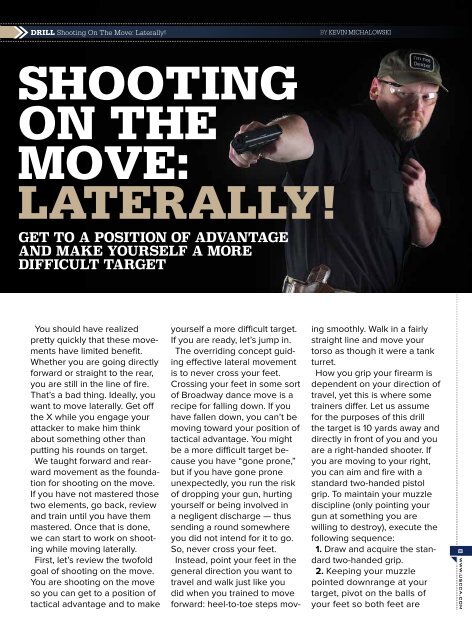You also want an ePaper? Increase the reach of your titles
YUMPU automatically turns print PDFs into web optimized ePapers that Google loves.
DRILL Shooting On The Move: Laterally!<br />
BY KEVIN MICHALOWSKI<br />
<strong>SHOOTING</strong><br />
ON THE<br />
MOVE:<br />
LATERALLY!<br />
GET TO A POSITION OF ADVANTAGE<br />
AND MAKE YOURSELF A MORE<br />
DIFFICULT TARGET<br />
You should have realized<br />
pretty quickly that these movements<br />
have limited benefit.<br />
Whether you are going directly<br />
forward or straight to the rear,<br />
you are still in the line of fire.<br />
That’s a bad thing. Ideally, you<br />
want to move laterally. Get off<br />
the X while you engage your<br />
attacker to make him think<br />
about something other than<br />
putting his rounds on target.<br />
We taught forward and rearward<br />
movement as the foundation<br />
for shooting on the move.<br />
If you have not mastered those<br />
two elements, go back, review<br />
and train until you have them<br />
mastered. Once that is done,<br />
we can start to work on shooting<br />
while moving laterally.<br />
First, let’s review the twofold<br />
goal of shooting on the move.<br />
You are shooting on the move<br />
so you can get to a position of<br />
tactical advantage and to make<br />
yourself a more difficult target.<br />
If you are ready, let’s jump in.<br />
The overriding concept guiding<br />
effective lateral movement<br />
is to never cross your feet.<br />
Crossing your feet in some sort<br />
of Broadway dance move is a<br />
recipe for falling down. If you<br />
have fallen down, you can’t be<br />
moving toward your position of<br />
tactical advantage. You might<br />
be a more difficult target because<br />
you have “gone prone,”<br />
but if you have gone prone<br />
unexpectedly, you run the risk<br />
of dropping your gun, hurting<br />
yourself or being involved in<br />
a negligent discharge — thus<br />
sending a round somewhere<br />
you did not intend for it to go.<br />
So, never cross your feet.<br />
Instead, point your feet in the<br />
general direction you want to<br />
travel and walk just like you<br />
did when you trained to move<br />
forward: heel-to-toe steps moving<br />
smoothly. Walk in a fairly<br />
straight line and move your<br />
torso as though it were a tank<br />
turret.<br />
How you grip your firearm is<br />
dependent on your direction of<br />
travel, yet this is where some<br />
trainers differ. Let us assume<br />
for the purposes of this drill<br />
the target is 10 yards away and<br />
directly in front of you and you<br />
are a right-handed shooter. If<br />
you are moving to your right,<br />
you can aim and fire with a<br />
standard two-handed pistol<br />
grip. To maintain your muzzle<br />
discipline (only pointing your<br />
gun at something you are<br />
willing to destroy), execute the<br />
following sequence:<br />
1. Draw and acquire the standard<br />
two-handed grip.<br />
2. Keeping your muzzle<br />
pointed downrange at your<br />
target, pivot on the balls of<br />
your feet so both feet are<br />
8<br />
WWW.USCCA.COM


